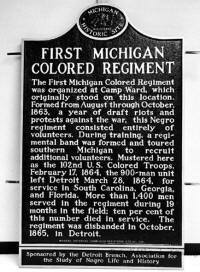| |
Historic
black
military
unit
disbanded
150
years
ago this
month
By
Ken
Coleman/Special
to Tell
Us USA
Mr.
Coleman
is a
Detroit-based
author
and
historian.
He can
be
reached
at
www.onthisdaydetroit.com
 DETROIT,
MI (Tell
Us USA)
- Their
service
to our
country
ended
150
years
ago.
Their
heroic
effort
has been
documented.
Their
home
turf has
been
memorialized. DETROIT,
MI (Tell
Us USA)
- Their
service
to our
country
ended
150
years
ago.
Their
heroic
effort
has been
documented.
Their
home
turf has
been
memorialized.
Yet, few
of their
descendants
know of
their
remarkable
story.
The men
exhibited
honor
and
dedication
in spite
of
intense
hate and
discrimination
leveled
against
them.
In July
1863,
Michigan
Gov.
Austin
Blair
was
authorized
by the
nation’s
Secretary
of War
to
organize
a
regiment
of black
infantrymen.
Yes,
some of
the very
same
people
who had
been
slaves,
chattel,
and
considered
only
three-fifths
of a
human by
the
white
men who
founded
our
nation.
One
thousand
six
hundred
and
seventy-three
African-American
men
served
in the
unit for
nearly
two
years
and were
supervised
by
whites.
The
regiment,
organized
at Camp
Ward on
Detroit’s
lower
east
side,
was
known
originally
as the
First
Regiment
of
Colored
Infantry.
The
outfit
was
formed
on
February
17,
1863,
after an
editorial
and
letter
writing
campaign
by Henry
Barnes,
a white
editor
at the
Detroit
Tribune
and
Advertiser.
The unit
later
became
the
102nd
United
States
Colored
Troops
on
August
12,
1863.
On
February
17,
1864,
they
left
Detroit
for
Annapolis,
Maryland
and
joined
the 9th
Army
Corps.
The men
also
served
in South
Carolina,
Georgia,
and
Florida.
Only 10
percent
of them
died
during
service.
Five
died in
action;
116
departed
after
contracting
diseases
such as
chickenpox,
smallpox,
scarlet
fever,
measles
mumps
and
whooping
cough;
and 114
were
discharged
after
sustaining
a
disability.
I share
the same
last
name as
four men
who
served,
according
to
Record
First
Michigan
Colored
Infantry
Civil
War,
1861-1865:
•
Enlisted
in
Company
F on
December
13,
1863,
John W.
Coleman’s
service
began at
age 18.
He died
of
disease
on July
2, 1864,
while in
Beaufort,
South
Carolina.
He was
buried
there.
•
Enlisted
in
Company
C on
October
21,
1863,
Morris
Coleman
service
began at
age 38.
He
deserted
his
colleagues
on
February
20,
1864.
•
Drafted
at age
27,
Benjamin,
a
Berrien
County
resident,
joined
his
military
unit on
November
2, 1863.
•
Enlisted
in
Company
F on
December
22,
1863,
William
W.
Coleman’s
service
commenced
at age
21. His
outfit
fought
at
Charleston,
S.C. on
September
30,
1865.
They
earned
$10 per
month
and
survived
on one
ration
per day.
Three
dollars
of
monthly
pay was
deducted
for
their
uniforms:
a heavy
as lead
sack
coat and
trousers
made of
wool; a
pair of
ankle-high
leather
brogans
boots; a
forage
cap; a
metal
canteen
design
to hold
cool
water;
and a
bayonet
and
musket.
Some of
the
early
volunteers
were
escaped
slaves
who
trekked
along
the
Underground
Railroad,
which
included
a stop
at
Second
Baptist
Church,
Michigan’s
first
black
congregation
founded
in 1836.
Here’s
an
account
from
Record
First
Michigan
Colored
Infantry,
Civil
War
1861-1865:
"It was
soon
detached
and sent
by
transports
to
Hilton
Head,
South
Carolina,
where it
arrived
April
19,
1864.
For two
months,
the
different
companies
did
picket
duty at
St.
Helena
and
Jenkins
Islands
and at
Hilton
Head
Island.
The
regiment
then
occupied
Port
Royal
and
assisted
in
constructing
fortifications
and
other
fatigue
duty. In
August,
the
regiment
was sent
to
Jacksonville,
Fla.;
then
marched
to
Baldwin,
where it
destroyed
railroad
tracks.
It was
attacked
by the
enemy
and
during
the
engagement
the
regiment
convinced
its
officers
that the
men
could be
relied
upon
when
serious
service
was
demanded.
After a
long
march
from
through
Eastern
Florida,
they
first
embarked
on
transports
at
Magnolia
for
Beaufort,
S.C. In
September,
it was
sent to
different
points
at Coosa
and Port
Royal
Islands
and in
October
the
enemy
attempted
to
surprise
and
capture
the
regiment
but was
repulsed
and
driven
off.”
Ultimately,
Confederate
General
Robert
E. Lee
surrendered
to Union
leader
General
Ulysses
S. Grant
at
Appomattox
Court
House,
Virginia
on April
12,
1865,
ending
the
Civil
War. The
black
men
arrived
back in
Detroit
and
disbanded
on
October
17,
1865.
To
remember
their
effort,
a
Michigan
Historic
Site
marker
was
created
on March
1, 1968,
and put
in place
on April
12,
1968. It
sits on
the
campus
of
Duffield
School
near
Macomb
and
Chene
streets.
We have
the
Detroit
Branch
of the
Association
for the
Study of
Negro
Life and
History
to thank
for
preserving
this
important
slice of
our
nation’s
history.
I only
wish
that our
grade
schools
presented
it in
such a
way that
students
who
scurry
past the
historic
marker
as they
make
their
way to
and from
class
would
know the
story of
the
First
Michigan
Colored
Regiment
as well
as far
too many
of us
know
episodes
of
Empire,
Scandal
and Real
Housewives
of
Atlanta.
Ken
Coleman
is a
Detroit-based
author
and
historian.
He can
be
reached
at
www.onthisdaydetroit.com
|